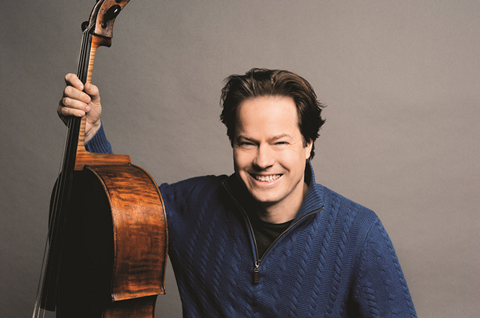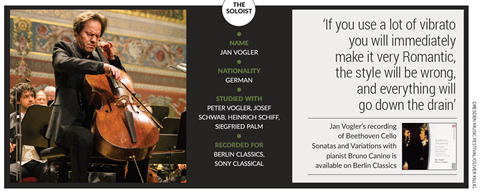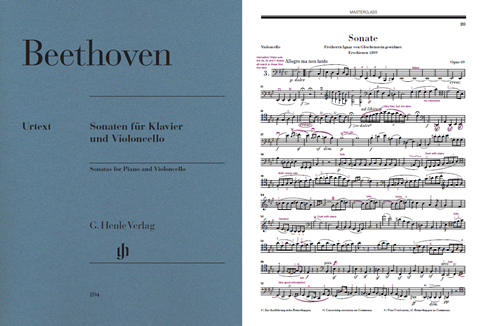Cellist Jan Vogler explores the first movement of the first-ever sonata to give equal weight to both piano and cello

This is the greatest cello sonata written before the time of Brahms, and it is a must for any cello student. I’ve performed it perhaps 300 times, and it’s a masterpiece of the cello literature, because for the first time in the history of music the piano and the cello parts are equal.
There’s a famous sketch in the archives of the Beethoven-Haus Bonn showing that Beethoven crossed out many of the themes originally in the piano part and wrote them into the cello part instead. This was probably inspired by a great cellist of his time, Antonín Kraft, for whom he wrote the hugely difficult ‘Triple’ Concerto. Only a master at that time could have played that, and the same can be said of this A major Sonata.
It is an aristocratic, temperamental piece, full of musical expression and imagination. Its form is perfect, and it shows Beethoven’s great taste.

Interpretative challenges
I first played this piece aged 17 and, looking back, I think I failed completely. I worked on it with my pianist for some 60 hours and we were so spirited after the rehearsals! But it was too mature for us, too demanding in terms of experience and Beethovenian interpretation. We were musically naive, our performance was unbalanced and our tempo was wrong.
Beethoven marks the dynamics, sforzandos and other points very clearly; and it is obvious where the piano dominates, where the cello dominates and where it’s a duet. We didn’t understand that the most masterful thing to do would be to match Beethoven’s intentions. It is middle Beethoven; the music is confident and balanced, and that balance is the slippery ground on which cellists walk.
It’s a tough piece and it has a lot of traps. In general it isn’t a sonata where you can just ‘do your thing’, although there are moments you can make your own: bars 36 and 37, for example; and bar 50, which can be very eccentric before starting anew in bar 51. Here the duet material from bar 38 is reversed: where originally the cello played scales and the piano played the theme, now the cello plays the theme and the piano plays scales.
It’s an important moment in the musical spiel, and it’s important to mark sections sharply in this way to highlight the musical architecture.

Choosing the right tempo
If you play this piece too slowly, its architecture and spirit will be lost; if you are too fast, it loses its depth. The time signature is 4/4, and really you should play 95 per cent of it at 𝅗𝅥 = 65. There are moments that are free, but even the ad libitum in bar 24 will sound terrible if you make a Romantic statement out of it by playing it at half speed! Keep a spirited feel, and stay bound to one tempo throughout.
Some people play the development, from bar 104, in a very free tempo, but I think you should not be allowed to slow down too much, or you will have to speed up noticeably for the recapitulation in bar 152. I also think it’s a mistake to play the opening out of time, as was often done in the 1960s and 70s: it should sound in tempo, or the music before the first fermata in bar 12 will become an introduction and it will sound as though the first a tempo only comes in bar 25.
Articulation
The forte sforzandos in bars 25–28 need an incredible amount of bow: use three-quarters for each sforzando, and a quarter for each other note, to bring them out quite drastically. Similarly, in bar 66 the forte pizzicatos need an extreme amount of power behind them, close to the bridge. In bar 71, you will have to articulate the rhythm enormously to create a grim and fiery feeling on the C string. It’s a rhythmical and magical theme, and it needs extreme bow control. In contrast, the little runs in bar 80 have to come out over the piano theme like a flying angel. Getting that lightness is not so easy.
The next trap to come is the bridge passage into the development section, from the second-time bar (bar 94). Playing without vibrato here will help you to keep up the tempo, and to dilute the music a bit before the sforzandos begin again in bar 99. Many cellists slow down tremendously here and have to pick up the speed again for the semiquavers (s) in bar 115, but it’s better to arrive at the same tempo.
In bar 124, make sure you don’t slow down or diminuendo, so that your subito piano is more effective in bar 125. Stay emotional for the beautiful, sentimental phrase that follows, using lots of bow and a light arm – don’t get stuck. If it flows, everything will fall into place.
Then it’s forte again from bar 137; test how extreme you can make the articulation in bar 138! If this works well, you can fall back into the non-vibrato pianissimo in the right tempo, and everything will move naturally. You can then add a little more vibrato from bar 150, to warm the sound before the theme comes back. As a general point, I like all the grace notes to be played before the beat. To me, this sounds far more musical.
Vibrato
You have to be careful with vibrato in this first movement: mostly the sound colour and phrasing should come from the right arm. I use only a small amount of slow vibrato for the beautiful theme. Middle Beethoven can sound quite Romantic, so if you use a lot of vibrato you will immediately make it very Romantic, the style will be wrong, and everything will go down the drain. Use different vibratos, but stay on the conservative side, particularly from bar 253, which risks sounding very cheesy if you are not careful. You could listen to Beethoven interpretations by John Eliot Gardiner or Nikolaus Harnoncourt, and play with that orchestral sound in mind; or think of a natural trumpet. It’s not that we have to play non-vibrato, but we do have to understand the amount of vibrato a piece like this can take. We can’t play it like Grieg or Brahms! Instead, vibrato should be there as a decoration, applied naturally when it is needed.
Intonation
The first theme is extremely difficult for intonation. In the first five bars, the F sharps have to be in perfect 4ths with the C sharps, and the As and Es have to be in perfect 5ths with each other. It is very important that the first 5th is absolutely perfect, and that the step from the E to the F sharp is not too big. If you play the F sharp a little too high, you’ll ruin the perfect 4th between that and the C sharp, and you risk playing the next E, in bar 3, too high, so that it doesn’t match the E in bar 1. In bar 4, there is a hidden 4th between the A and the E (the G sharp is just a passing note), so again, this 4th has to be perfect, and the A must be the same pitch as it was in bar 1. I record myself on my phone to check that the Es, As and F sharps are all the same; the passing notes will look after themselves.

Recordings
For something a bit different, listen to Anner Bylsma’s recording using gut strings, with Malcolm Bilson on the fortepiano. It has a good spirit, and it will help you to understand what the music sounded like in Beethoven’s time. Next time you rehearse, you might say to your pianist, ‘I listened to how the piano at Beethoven’s time sounded, and there was more articulation and less sound. Can you recreate that on a modern piano?’
My teacher Heinrich Schiff made a very good recording of this piece with pianist Till Fellner. It’s intelligent, but not too academic; it’s lively and temperamental, with all the varied dynamics and themes done in very good taste. They play with modern strings and piano, but definitely with Bylsma’s sound in mind.
Finally, listen to Rostropovich and Richter, live from the Edinburgh Festival. Perhaps it is stylistically out of date, but it is a great example of the traditional Beethoven A major interpretation. If you listen to these three recordings, you’ll have covered everything.
INTERVIEW BY PAULINE HARDING
To see the Henle Verlag sheet music marked-up by Jan Vogler for this Masterclass, download The Strad’s May 2017 issue on desktop computer or via the The Strad App, or buy the print edition
Watch: The Strad Masterclass: Pieter Wispelwey on Brahms Cello Sonata op.99
Watch: The Strad Masterclass: cellist Wolfgang Emanuel Schmidt on Schumann’s Adagio and Allegro
Watch: The Strad Masterclass: Danjulo Ishizaka on the Grieg Cello Sonata
Reference
Masterclass: Julia Fischer on Beethoven’s Violin Concerto, Third Movement
- 1
- 2
- 3
- 4
 Currently reading
Currently readingMasterclass: Jan Vogler on Beethoven Cello Sonata op.69
- 5
- 6
















































No comments yet